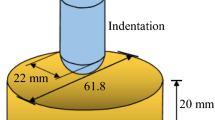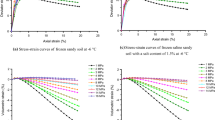Abstract
A series of triaxial creep tests were conducted on warm frozen silts extracted from Qinghai–Tibet Plateau at temperature of −1.5 °C under confining pressures of 0.5, 1.0, and 2.0 MPa, respectively. The applied test stress levels were 30, 50, 60, and 70% of triaxial shear strength, respectively. The test results indicate that the creep strain increases with the increase in applied stress level and there is a stress threshold, based on which the test results can be classified into two types of creep strain curves. The creep strain curve only includes primary and secondary creep stages when the stress level is less than the threshold value. When the stress level exceeds the threshold value, the creep strain velocity gradually increases and the specimen quickly fails in tertiary creep stage. Based on the creep test results, a fractional order rheological element model is established for warm frozen silt, which is also generalized from uniaxial stress state to the three-dimensional stress state. From the analysis on the features of the stress threshold, a creep strength criterion is also proposed simultaneously. Comparing the calculated results of the warm frozen silt with the tested ones, it is found that the predicted results of the proposed model are in good agreement with the test results. In the proposed fractional order model, the relationship between the damage factor and time is established to describe the damage degree of the specimen. Compared with the existing creep constitutive model of frozen soil, the proposed fractional order model has advantages of fewer model parameters, higher simulation precision and wider applicability in analyzing the mechanical properties of warm frozen silt.










Similar content being viewed by others
References
Arenson LU, Springman SM (2005) Mathematical descriptions for the behaviour of ice-rich frozen soils at temperature close to 0 °C. Can Geotech J 42(2):431–442
Arenson LU, Springman SM, Sego DC (2007) The rheology of frozen soils. Appl Rheol 17:1–14
Cheng GD (2003) Construction of Qinghai–Tibetan railway with cooled roadbed. China Railw Sci 24(3):1–4
Darabi MK, Abu Al-Rub RK, Masad EA, Huang CV, Dallas NL (2011) A thermo viscoelastic viscoplastic viscodamage constitutive model for asphaltic materials. Int J Solids Struct 48(1):191–207
Enelund M, Mahler L, Runesson K, Josefson BL (1999) Formulation and integration of the standard linear viscoelastic solid with fractional order rate laws. Int J Solids Struct 36(16):2417–2442
Fabrizio M (2014) Fractional rheological models for thermomechanical systems dissipation and free energies. Fract Calc Appl Anal 1(17):207–223
Fish AM (1991) Strength of frozen soil under a combined stress. In: 6th International Symposium on Ground Freeging, pp 135–145
Katsuki D, Gutierrez M (2011) Viscoelastic damage model for asphalt concrete. Acta Geotech 6:231–241
Kiryakova V, Al-Sauabi B (1999) Explicit solutions to hyper-Bessel integral equations of second kind. Comput Math Appl 37:75–86
Kutergin VN, Kal’bergenov RG (2012) Influence of salinity on rheologic and strength properties of frozen soils in yamal. Soil Mech Found Eng 49(6):105–111
Lai YM, Li JB, Li QZ (2012) Study on damage statistical constitutive model and stochastic simulation for warm ice-rich frozen silt. Cold Reg Sci Technol 71:102–110
Lai YM, Jin L, Chang XX (2009) Yield criterion and elasto–plastic damage constitutive model for frozen sandy soil. Int J Plast 25(6):1177–1205
Lai YM, Yang YG, Chang XX, Li SY (2010) Strength criterion and elastoplastic constitutive model of frozen silt in generalized plastic mechanics. Int J Plast 26(10):1461–1484
Li DW, Fan JH, Wang RH (2011) Research on visco-elastic–plastic creep model of artificially frozen soil under high confining pressures. Cold Reg Sci Technol 65:219–225
Ma XJ, Zhang JM, Chang XX, Zheng B (2007) Experimental study on creep of warm and ice-rich frozen soil. Chin J Geotech Eng 29(6):848–852
Madurapperuma MAKM, Puswewala UGA (2008) Numerical implementation of a constitutive model for soil creep. J Mech Mater Struct 12:1857–1874
Marklund E, Eitzenberger J, Varna J (2008) Nonlinear viscoelastic viscoplastic material model including stiffness degradation for hemp/lignin composites. Compos Sci Technol 68(9):2156–2162
Qin YH, Zhang JM, Zheng B, Ma XJ (2009) Experimental study for the compressible behavior of warm and ice-rich frozen soil under the embankment of Qinghai–Tibet Railroad. Cold Reg Sci Technol 57:148–153
Schiessel H, Metzler R, Blumen A, Nonnenmacher TF (1995) Generalized viscoelastic models: their fractional equations with solutions. J Phys A Math Theor 28:6567–6584
Sumelka W (2014) Fractional viscoplasticity. Mech Res Commun 56:31–36
Sun J (2007) Rock rheological mechanics and its advance in engineering applications. Chin J Rock Mech Eng 6(26):1081–1107
Wang SH, Qi JL, Yao XL (2011) Stress relaxation characteristics of warm frozen clay under triaxial conditions. Cold Reg Sci Technol 69:112–117
Wu ZW, Ma W (1994) Strength and creep of frozen soil. Lanzhou University Press, Lanzhou, pp 20–26
Wu ZW, Ma W (1994) Strength characteristic of frozen soil. J Glaciol Geocryol 16(1):15–20
Xu Z, Chen W (2013) A fractional-order model on new experiments of linear viscoelastic creep of Hami Melon. Comput Math Appl 66:677–681
Yang YG, Lai YM, Chang XX (2010) Experimental and theoretical studies on the creep behavior of warm ice-rich frozen sand. Cold Reg Sci Technol 63:61–67
Yin DS, Wu H, Cheng C, Chen YQ (2013) Fractional order constitutive model of geomaterials under the condition of triaxial test. Int J Numer Anal Meth Geomech 37:961–972
Yu YJ, Tian XG, Lu TJ (2013) On fractional order generalized thermoelasticity with micromodeling. Acta Mech 224:2911–2927
Zheng B, Zhang JM, Ma XJ (2009) Study on Compression deformation of warm and ice-enriched frozen soil. Chin J Rock Mech Eng 28(Supp. 1):3063–3068
Zhao X, Yang HT, He YQ (2014) Identification of constitutive parameters for fractional viscoelasticity. Commun Nonlinear Sci Numer Simul 19:311–322
Zhao XD, Zhou GQ (2013) Experimental study on the creep behavior of frozen clay with thermal gradient. Cold Reg Sci Technol 86:127–132
Zhou HW, Wang CP, Han BB, Duan ZQ (2011) A creep constitutive model for salt rock based on fractional derivatives. Int J Rock Mech Min Sci 48:116–121
Zhou HW, Wang CP, Mishnaevsky L, Duan ZQ, Ding JY (2013) A fractional derivative approach to full creep regions in salt rock. Mech Time-Depend Mater 17:413–425
Acknowledgments
This research was supported by National Key Basic Research Program of China (973 Program No. 2012CB026102), National Natural Science Foundation of China (41230630, 51204161), the Western Project Program of the Chinese Academy of Sciences (KZCX2-XB3-19), the foundation of State Key Laboratory of Frozen Soil Engineering (SKLFSE-ZY-03), and CAS Pioneer Hundred Talents Program.
Author information
Authors and Affiliations
Corresponding author
Rights and permissions
About this article
Cite this article
Liao, M., Lai, Y., Liu, E. et al. A fractional order creep constitutive model of warm frozen silt. Acta Geotech. 12, 377–389 (2017). https://doi.org/10.1007/s11440-016-0466-4
Received:
Accepted:
Published:
Issue Date:
DOI: https://doi.org/10.1007/s11440-016-0466-4




